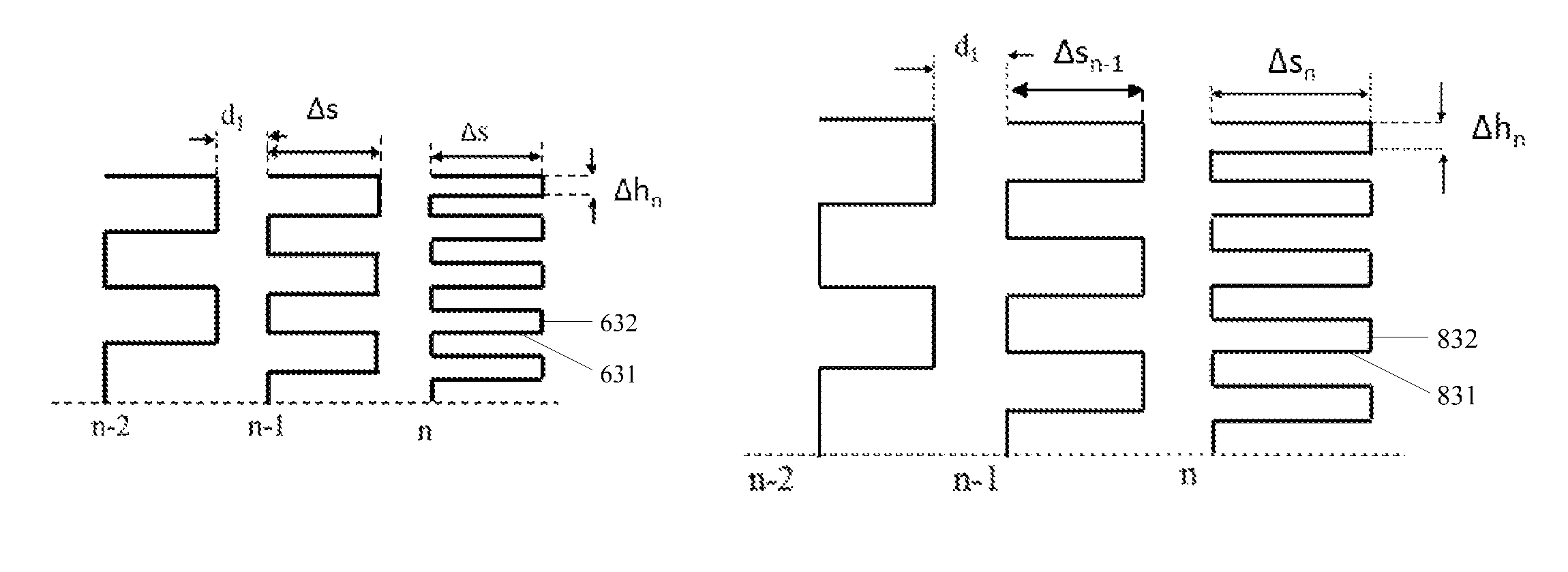Liquid crystal display panel and fan-out area thereof
a liquid crystal display panel and fanout area technology, applied in non-linear optics, instruments, optics, etc., can solve the problems of poor display effect, large large wire resistance differences, so as to reduce resistance differences among wires, relieve or relieve
- Summary
- Abstract
- Description
- Claims
- Application Information
AI Technical Summary
Benefits of technology
Problems solved by technology
Method used
Image
Examples
first embodiment
[0056]FIG. 4 is a schematic structural top view of a fan-out area according to the present invention, and FIG. 5 is a schematic partial structural view of three neighboring wires. Please refer to FIGS. 4 and 5 together:
[0057]The fan-out area 40 includes a plurality of wires. The wires are classified into a middle wire 41 arranged at a middle region of the fan-out area 40 and a plurality of fan-out wires 42 arranged at two sides of the middle wire 41. In the illustrated embodiment, the fan-out wires 42 are symmetrically arranged at the two sides of the middle wire 41, and any two neighboring wires of the wires have a distance d1 same as that of another two neighboring wires of the wires.
[0058]The middle wire 41 and the fan-out wires 42 each are disposed with at least one first wire pattern 43. Moreover, along each of directions toward the middle wire 41, widths of the first wire patterns 43 of different wires (including the middle wire 41 and the fan-out wires 42) are successively in...
second embodiment
[0068]FIG. 6 is a schematic structural top view of a fan-out area according to the present invention, and FIG. 7 is a schematic partial structural view of three neighboring wires in FIG. 6. Please refer to FIGS. 6 and 7 together:
[0069]The fan-out area 60 in the second embodiment will be described on the basis of the first embodiment illustrated in FIGS. 4 and 5, a difference is that: in the fan-out area 60 of this embodiment, along each of the directions toward the middle wire 61, lengths of second sub-patterns 632 of different wires are successively decreased while widths of the second sub-patterns 632 of the different wires are kept unchanged, and lengths of first sub-patterns 631 of the different wires are the same. Preferably, the lengths of the second sub-patterns 632 of the different wires are successively decreased with a second amplitude. The above-mentioned first amplitude and the second amplitude are without necessarily mathematical relationship, and thus can be the same o...
third embodiment
[0075]FIG. 8 is a schematic structural top view of a fan-out area according to the present invention, and FIG. 9 is a schematic partial structural view of three neighboring wires in FIG. 8. Please refer to FIGS. 8 and 9 together:
[0076]A fan-out area 80 in this embodiment will be described on the basis of the first embodiment as illustrated in FIGS. 4 and 5, and a difference is that: in the fan-out area 80 of this embodiment, along each of the directions toward the middle wire 81, lengths of second sub-patterns 832 of different wires are successively decreased and widths of the second sub-patterns 832 of the different wires are kept unchanged, and the lengths of the first sub-patterns 831 of the different wires are successively increased.
[0077]Likewise, by combining the expressions 1-13 through 1-16 ought to be satisfied by the width Δs and the length Δh of the arcuate patterns in the prior art with a route (rather than length) of the second wire pattern 84 and the turning part 85 of...
PUM
| Property | Measurement | Unit |
|---|---|---|
| lengths | aaaaa | aaaaa |
| width | aaaaa | aaaaa |
| length | aaaaa | aaaaa |
Abstract
Description
Claims
Application Information
 Login to View More
Login to View More - R&D
- Intellectual Property
- Life Sciences
- Materials
- Tech Scout
- Unparalleled Data Quality
- Higher Quality Content
- 60% Fewer Hallucinations
Browse by: Latest US Patents, China's latest patents, Technical Efficacy Thesaurus, Application Domain, Technology Topic, Popular Technical Reports.
© 2025 PatSnap. All rights reserved.Legal|Privacy policy|Modern Slavery Act Transparency Statement|Sitemap|About US| Contact US: help@patsnap.com



